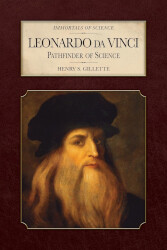Leonardo da Vinci: Pathfinder of Science

Author:
Henry S. Gillette
Illustrator:
Henry S. Gillette
Publication:
1962 by Franklin Watts, Inc
Genre:
Art, Biography, Non-fiction, Science
Series:
Immortals of Science ![]() Members Only (World History)
Members Only (World History)
Pages:
168
Current state:
This book has been evaluated and information added. It has been read but content considerations may not be complete.
Book Guide
Search for this book used on:
This biography is the story of Leonardo da Vinci as a scientist, for his extraordinary vision concerning scientific ideas created an impact that is felt in the world today. Many of Leonardo's ideas were in advance of his own time; they include a flying machine, a tank, a rapid-firing gun, and a parabolic compass. Leonardo's invention of an irrigation system can be said to be the start of the study of hydraulics, and his ideas concerning optics, engineering, and architecture were also extremely advanced.
Leonardo came close to becoming the "all-around" Renaissance man. Trained as an artist, he not only achieved recognition as one of the greatest painters the world has ever known, he was equally successful as a poet, an engineer, an anatomist and a scientist in general.
Although the mention of Leonardo's name is likely to bring to mind his Last Supper and Mona Lisa, it was the freshness and inventiveness of his scientific mind that most greatly enhances his legacy to mankind.
From the dust jacket
To view an example page please sign in.
Content Guide
Please sign in to access all of the topics associated with this book and view other books with the same topics.
Please sign in to access the locations this book takes place in and view other books in the same location.
Please sign in to access the time periods this book takes place in and view other books in the same time period.
For information about the lead characters please sign in.
Reviews

The Immortals of Science Series
Reviewed by Sara Masarik
These books are of varying lengths based on how much is known about the lives of the subject. Whatever the length, I sped through each one as though it were a suspense novel. How will this one manage to carry on his work in the midst of civil war? How can that one earn the respect of the scientific community so his work can be published for the world? What will be the exciting sequence of events that will lead to the ultimate breakthrough? Will he live long enough to find the answer he has searched for all his life?
The science in these books is written in language any curious reader will be able to understand. The authors don’t condescend, but the writing is not above a confident reader, perhaps ten and above. They would also be interesting enough for reading aloud so they can be shared with the entire family, whatever their ages.
Please sign in to read Biblioguides member reviews.
Find This Book
Search for this book used on:



